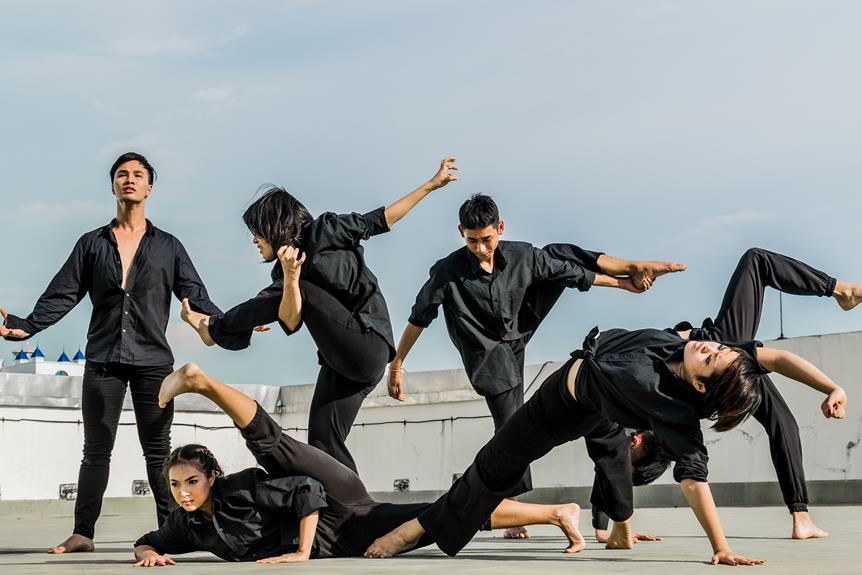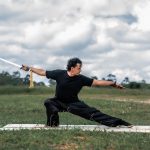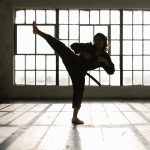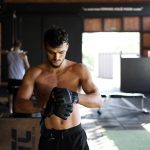In the world of martial arts and MMA, achieving optimal flexibility and strength is essential for success. Just as a well-honed blade requires both flexibility and strength to perform at its best, so too do martial artists and MMA practitioners.
This article presents the 15 best stretches specifically designed to target key muscle groups crucial for martial arts and MMA. By incorporating these stretches into their training regimen, athletes can enhance their performance, reduce the risk of injury, and achieve mastery in their craft.
Key Takeaways
- Hip stretches improve flexibility and strength in hip muscles, enhancing range of motion and reducing the risk of strain or injury in the hip area.
- Leg stretches, particularly hamstring stretches, enhance kicks and flexibility in martial arts, preventing strains or tears during high-intensity training or competitions.
- Spine stretches improve flexibility and range of motion in the spine, promoting better posture, alignment, and overall performance while minimizing the risk of injury.
- Inner thigh and groin stretches enhance overall flexibility and strength, increasing range of motion and improving kicking techniques while reducing the risk of injury.
Hip Flexor Stretches
Hip flexor stretches are essential for improving flexibility and strength in the hip muscles, which is crucial for martial arts performance. These stretches target the muscles at the front of the hips, including the iliopsoas and rectus femoris. By increasing flexibility in the hip flexors, martial artists can achieve a greater range of motion in kicks, punches, and ground movements, allowing them to execute techniques with more power and precision.
The benefits of incorporating hip flexor stretches into martial arts training are numerous. Improved hip flexibility can enhance kicking techniques by increasing the height and speed of kicks. It also helps in maintaining balance during dynamic movements and prevents strain or injury in the hip area. Additionally, strong and flexible hip muscles contribute to overall lower body stability and core strength, which are essential for generating power and executing explosive movements.
However, it is important to avoid common mistakes when performing hip flexor stretches for martial arts training. One common mistake is overstretching, which can lead to muscle strains or tears. It is crucial to listen to your body and stretch within a comfortable range of motion. Another mistake is neglecting other muscle groups. While hip flexors are important, it is essential to maintain a balanced stretching routine that targets all major muscle groups involved in martial arts movements.
Hamstring Stretches
Hamstring stretches play a crucial role in martial arts training by improving flexibility and strength in the muscles at the back of the thighs, further enhancing overall performance and reducing the risk of injury. Effective hamstring stretches are essential for improved kicks and flexibility in martial arts, allowing practitioners to achieve higher kicks with greater ease and range of motion. Additionally, hamstring flexibility is of utmost importance in preventing injuries in MMA fighters. By stretching the hamstrings regularly, fighters can maintain optimal muscle length and prevent strains or tears during high-intensity training or competitions. Incorporating hamstring stretches into a regular stretching routine is highly recommended to maintain flexibility, reduce tightness, and promote overall muscle health. Here are two effective hamstring stretches for martial artists:
| Hamstring Stretches | |
|---|---|
| Seated Forward Bend | Standing Toe Touch |
| Benefits: | Benefits: |
| – Lengthens and stretches | – Stretches the |
| hamstring muscles | hamstrings |
| – Improves flexibility | – Increases hamstring |
| in the back of thighs | flexibility |
| – Relieves lower back | – Enhances range of |
| tension | motion for kicks |
Spinal Stretches
Continuing to prioritize flexibility and strength in martial arts training, spinal stretches are an essential component to enhance overall performance and minimize the risk of injury. The benefits of spinal stretches for martial arts practitioners are numerous. They improve flexibility and range of motion in the spine, increase blood flow and oxygenation to the muscles, and promote better posture and alignment. Incorporating spinal stretches into your martial arts training routine is simple and effective.
Here's how to do it:
- Start with the supine spinal twist, lying on your back and gently twisting your spine from side to side.
- Next, try the triangle pose (Trikonasana), standing with your feet wide apart and reaching one hand towards the floor while extending the other hand towards the ceiling.
- Another great stretch is the cat-cow pose, moving between rounding and arching your back while on all fours.
- Finally, include the seated forward bend, sitting with your legs straight and reaching forward to touch your toes.
Inner Thigh and Groin Stretches
To further enhance overall flexibility and strength in martial arts training, it is crucial to incorporate effective stretches for the inner thigh and groin muscles. Inner thigh and groin stretches offer numerous benefits, such as increased range of motion, improved kicking techniques, and reduced risk of injury.
One of the most effective stretches for this area is the Butterfly Stretch, also known as Baddha Konasana. To properly perform this stretch, sit on the floor, bring the soles of your feet together, and gently press your knees towards the ground.
Another effective stretch is the Side Splits, which involves spreading your legs as wide apart as possible while keeping your knees straight. Remember to warm up before attempting these stretches and hold each position for at least 30 seconds to achieve maximum results.
Incorporating these stretches into your training routine will help you develop greater flexibility and strength in your inner thigh and groin muscles, ultimately improving your martial arts performance.
Leg Flexibility Stretches
For leg flexibility stretches, it is important to incorporate a variety of exercises that target different muscle groups in the legs. Having good leg flexibility is crucial for martial arts performance as it allows for greater range of motion, improves kicking technique, and reduces the risk of injuries.
Here are some effective leg flexibility exercises that can help increase kicking power:
- Front-to-Back Splits: This stretch helps to improve flexibility in the hamstrings, hip flexors, and inner thighs.
- Pigeon Stretch: This stretch targets the glutes, hip rotators, and hip flexors, enhancing the flexibility and mobility of the hips.
- Warrior 1 (Virabhadrasana I): This yoga pose stretches the hip flexors, quadriceps, and calves, while also building strength in the legs and core.
- Standing Side Leg Lift and Hold: This exercise targets the outer hips and thighs, improving balance and stability, which is essential for powerful kicks.
Incorporating these leg flexibility stretches into your training routine will not only enhance your kicking power but also contribute to overall martial arts performance.
Core and Leg Strength Stretches
For core and leg strength stretches, incorporating exercises that target the muscles in the abdomen and lower body is essential for improving overall martial arts performance. Core strength is crucial for generating power and stability in strikes, while leg strength provides a solid foundation for balance and explosive movements. Here are two effective exercises for improving core and leg strength in martial arts/MMA:
| Exercise | Muscles Targeted |
|---|---|
| Warrior 1 (Virabhadrasana I) | Abdominals, quadriceps, glutes |
| Warrior 2 (Virabhadrasana II) | Abdominals, hamstrings, quadriceps, glutes |
Warrior 1 is a standing pose that strengthens the core and lower body, while also improving balance and flexibility. Warrior 2 targets the same muscle groups but adds an element of lateral movement, further enhancing core stability and leg strength. Incorporating these exercises into your training routine will help you develop the strength and stability necessary for success in martial arts.
Shoulder and Chest Stretches
Continuing the focus on improving overall martial arts performance, the next area to address is the flexibility and strength of the shoulders and chest. Incorporating shoulder and chest stretches into your martial arts/MMA training routine offers numerous benefits.
- Improved Range of Motion: By stretching the shoulders and chest, you can increase the flexibility and mobility of these areas, allowing for a wider range of motion during strikes and grappling techniques.
- Injury Prevention: Stretching the shoulders and chest helps to reduce the risk of injuries such as shoulder impingements and muscle strains, which are common in martial arts.
- Enhanced Technique: Flexible shoulders and chest muscles contribute to better posture, balance, and form, leading to improved technique and execution of martial arts movements.
- Increased Power: By stretching the chest and shoulder muscles, you can enhance your striking power and speed, as well as your ability to generate force from the upper body.
To ensure you get the most out of your shoulder and chest stretches, it's important to avoid common mistakes. These include rushing through the stretches, neglecting proper form and alignment, and not holding the stretches for an adequate amount of time. By paying attention to these details, you can maximize the benefits of these stretches and improve your martial arts performance.
Hip Mobility Stretches
To further enhance overall martial arts performance, it is crucial to focus on improving hip mobility through specific stretches.
Hip mobility plays a vital role in executing powerful kicks, strikes, and fluid movements. It allows martial artists to generate maximum force and maintain balance and stability during techniques.
Improving hip mobility for better kicks and strikes can be achieved through targeted stretches such as the Lizard Stretch and the Pigeon Stretch.
The Lizard Stretch stretches the hip flexors, groin, and inner thighs, increasing range of motion and flexibility.
The Pigeon Stretch targets the hip rotators and glutes, improving hip mobility for smoother and more controlled kicks and strikes.
Incorporating these hip mobility stretches into a regular stretching routine will help reduce tightness and prevent injuries.
Lower Back Stretches
In addressing the subtopic of lower back stretches, it is essential to prioritize proper technique and form for optimal results. Incorporating lower back stretches in martial arts training is of utmost importance as it helps improve flexibility and strength, leading to better performance and reduced risk of injury.
To effectively stretch the lower back, consider the following techniques:
- Cat-Cow Stretch: Begin on all fours, arching your back upwards like a cat and then lowering it down like a cow. Repeat this movement for several repetitions.
- Child's Pose: Start by kneeling on the floor and then sit back on your heels, lowering your upper body forward until your forehead touches the ground. Hold this position for several deep breaths.
- Cobra Stretch: Lie on your stomach with your hands under your shoulders. Press your hands into the floor and lift your upper body, arching your back gently.
- Seated Forward Bend: Sit with your legs extended in front of you and slowly reach forward, trying to touch your toes. Hold this position for several breaths.
Incorporating these stretches into your martial arts training routine will help enhance your lower back flexibility and strength, ultimately improving your overall performance.
Balance and Stability Stretches
To further enhance overall flexibility and stability, martial artists can incorporate balance and stability stretches into their training routine. Balance and stability are crucial components of martial arts training as they contribute to improved performance, agility, and injury prevention. By focusing on exercises that target these areas, martial artists can develop better control over their movements, maintain proper body alignment, and react quickly to changes in their opponents' positions.
Here are two effective stretches that can help improve balance and stability for martial arts performance:
| Exercise | Technique | Benefits |
|---|---|---|
| Standing Side Leg Lift and Hold | Stand with feet hip-width apart. | Strengthens hip abductors and improves balance |
| Lift one leg out to the side and hold | Increases stability and improves body control | |
| for 10-15 seconds. | ||
| Warrior 1 (Virabhadrasana I) | Start in a lunge position with one | Strengthens legs, core, and improves balance |
| leg forward and the other leg | Increases hip flexibility and stability | |
| extended back. |
Incorporating these stretches into a regular training routine can help martial artists enhance their balance and stability, leading to improved performance and reduced risk of injury.
Full Body Relaxation Stretches
For martial artists looking to promote overall relaxation and flexibility, incorporating full body relaxation stretches into their training routine is essential. These stretches not only help to release tension in the muscles, but also provide numerous benefits for the mind and body.
Here are some techniques for deepening relaxation in stretching exercises:
- Focus on deep breathing: Take slow, deep breaths while performing the stretches to help relax the body and calm the mind.
- Use props for support: Utilize props such as yoga blocks or bolsters to provide support and enhance relaxation during the stretches.
- Incorporate visualization: Imagine your muscles becoming loose and relaxed as you hold each stretch, allowing yourself to fully let go of any tension.
- Practice mindfulness: Stay present and fully aware of your body and the sensations you are experiencing during each stretch, fostering a deeper sense of relaxation.
Hip and Glute Stretches
The incorporation of hip and glute stretches is crucial for martial artists seeking to enhance their overall flexibility and strength, building upon the foundation of full body relaxation stretches. By targeting the hip and glute muscles, practitioners can improve their range of motion, stability, and power in various martial arts techniques.
To activate the glutes effectively, glute activation exercises such as glute bridges and clamshells can be performed. These exercises specifically engage the glute muscles, preparing them for the demands of martial arts movements.
Additionally, hip mobility drills like hip circles and leg swings can improve the flexibility and mobility of the hip joints, allowing for smoother and more efficient execution of kicks, strikes, and takedowns.
Incorporating these stretches into a regular training routine will not only enhance performance but also reduce the risk of injury.
Agility and Lateral Movement Stretches
One essential stretch for enhancing agility and lateral movement in martial arts is the Cossack Squat. This stretch targets the adductor muscles and improves flexibility in the hips and groin. To perform the Cossack Squat, start in a wide stance with your feet pointing outwards. Shift your weight to one side and lower your body into a deep squat, keeping the other leg straight. Hold the position for a few seconds and then repeat on the other side.
To further enhance agility and lateral movement, you can try different variations of the Cossack Squat, such as adding a side reach or holding a weight. Another effective stretch for improving lateral movement is the Side Split. This stretch targets the inner thigh muscles and increases flexibility in the hips. Start by standing with your feet wider than shoulder-width apart and gradually lower your body into a deep squat, keeping your knees turned outwards. Hold the stretch for a few seconds and then slowly return to the starting position.
As you progress, you can work on increasing your range of motion by gradually widening your stance. Incorporating these stretches into your training routine will help you develop the agility and lateral movement necessary for martial arts mastery.
Outer Hip and Thigh Stretches
To further enhance flexibility and improve performance in martial arts, incorporating outer hip and thigh stretches into your routine is essential. These stretches target the muscles in the hips and glutes, which play a crucial role in agility and balance.
One effective stretch is the standing side leg lift and hold. Stand tall and lift one leg out to the side as high as you can, then hold the position for a few seconds before lowering it back down. This stretch helps to strengthen the hip and glute muscles while improving flexibility.
Another beneficial stretch is the Cossack squat. Start by standing with your feet wider than shoulder-width apart, then lower into a deep squat on one side while keeping the other leg straight. This stretch helps to open up the hips and increase flexibility in the outer thighs.
Overall Flexibility and Performance
Enhancing overall flexibility and performance is crucial for martial artists and MMA practitioners, as it allows for greater range of motion, improved technique execution, and reduced risk of injury.
A regular stretching routine offers numerous benefits, including increased flexibility, improved muscle strength, and enhanced joint stability. It also helps to alleviate muscle tightness and soreness, promoting quicker recovery and better overall performance.
However, it is important to note that a combination of stretches is recommended to target different muscle groups and movement patterns specific to martial arts and MMA. Integrating hip flexor stretches, hamstring stretches, spinal stretches, and core and leg strength stretches into your routine can help improve your overall flexibility and performance.
Frequently Asked Questions
How Often Should I Perform These Stretches to See Improvements in My Martial Arts/Mma Flexibility and Strength?
To see improvements in martial arts/MMA flexibility and strength, it is recommended to perform these stretches regularly. The frequency will depend on individual needs and goals. Consistency and dedication are key to achieving desired results.
Are There Any Modifications or Variations to These Stretches That Can Help Target Specific Areas or Muscles Used in Martial Arts/Mma?
There are various modifications and variations available to target specific muscle groups used in martial arts/MMA. These modifications can be tailored to different skill levels, allowing individuals to focus on their specific areas of improvement.
Can These Stretches Help With Injury Prevention and Recovery in Martial Arts/Mma?
Stretching is crucial for injury prevention and recovery in martial arts/MMA. It improves flexibility, increases range of motion, and reduces muscle tightness. Incorporating a regular stretching routine, along with targeted stretches, can significantly enhance overall performance and reduce the risk of injuries.
Are There Any Specific Warm-Up Exercises or Stretches That Should Be Done Before Performing These Stretches for Maximum Effectiveness?
To maximize the effectiveness of stretches for martial arts/MMA flexibility and strength, it is important to perform warm-up exercises beforehand. This helps prepare the body, increase blood flow, and enhance range of motion, ultimately improving performance and reducing the risk of injury.
Can These Stretches Also Help Improve Overall Athletic Performance, Not Just in Martial Arts/Mma?
Yes, these stretches can improve overall athletic performance, not just in martial arts/MMA. They enhance flexibility, strength, and mobility, reducing the risk of injury and enhancing overall fitness levels. Incorporating them into a regular routine can yield significant benefits.
Conclusion
In conclusion, incorporating a regular stretching routine that targets key muscle groups crucial for martial arts and MMA can greatly enhance flexibility and strength, as well as reduce the risk of injury. By consistently practicing the 15 best stretches outlined in this article, athletes can improve mobility, increase range of motion, and enhance muscular endurance.
One interesting statistic to note is that a study found that athletes who regularly stretch experienced a 20% decrease in the likelihood of sustaining a martial arts-related injury.
- 15 Best Martial Arts Weapons (Fighting & Training) - October 14, 2024
- Is Fencing a Martial Art? (Yes, 4 Reasons Why) - October 14, 2024
- 7 Best Martial Arts for Self-defense Ranked (Highly Effective) - October 14, 2024










